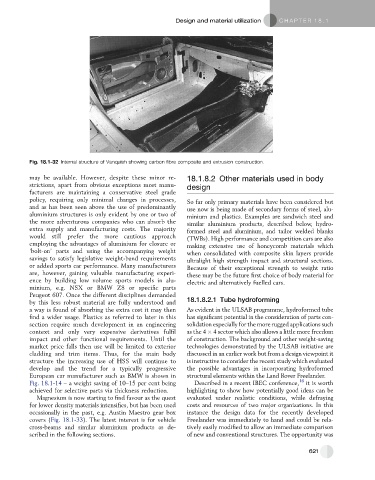Page 610 - Automotive Engineering Powertrain Chassis System and Vehicle Body
P. 610
Design and material utilization C HAPTER 18.1
Fig. 18.1-32 Internal structure of Vanquish showing carbon fibre composite and extrusion construction.
may be available. However, despite these minor re- 18.1.8.2 Other materials used in body
strictions, apart from obvious exceptions most manu- design
facturers are maintaining a conservative steel grade
policy, requiring only minimal changes in processes, So far only primary materials have been considered but
and as has been seen above the use of predominantly use now is being made of secondary forms of steel, alu-
aluminium structures is only evident by one or two of minium and plastics. Examples are sandwich steel and
the more adventurous companies who can absorb the similar aluminium products, described below, hydro-
extra supply and manufacturing costs. The majority formed steel and aluminium, and tailor welded blanks
would still prefer the more cautious approach (TWBs). High performance and competition cars are also
employing the advantages of aluminium for closure or making extensive use of honeycomb materials which
‘bolt-on’ parts and using the accompanying weight when consolidated with composite skin layers provide
savings to satisfy legislative weight-band requirements ultralight high strength impact and structural sections.
or added sports car performance. Many manufacturers Because of their exceptional strength to weight ratio
are, however, gaining valuable manufacturing experi- these may be the future first choice of body material for
ence by building low volume sports models in alu- electric and alternatively fuelled cars.
minium, e.g. NSX or BMW Z8 or specific parts
Peugeot 607. Once the different disciplines demanded
by this less robust material are fully understood and 18.1.8.2.1 Tube hydroforming
a way is found of absorbing the extra cost it may then As evident in the ULSAB programme, hydroformed tube
find a wider usage. Plastics as referred to later in this has significant potential in the consideration of parts con-
section require much development in an engineering solidation especially for the more rugged applications such
context and only very expensive derivatives fulfil as the 4 4 sector which also allows a little more freedom
impact and other functional requirements. Until the of construction. The background and other weight-saving
market price falls then use will be limited to exterior technologies demonstrated by the ULSAB initiative are
cladding and trim items. Thus, for the main body discussed in an earlier work but from a design viewpoint it
structure the increasing use of HSS will continue to is instructive to consider the recent study which evaluated
develop and the trend for a typically progressive the possible advantages in incorporating hydroformed
European car manufacturer such as BMW is shown in structural elements within the Land Rover Freelander.
Fig. 18.1-14 – a weight saving of 10–15 per cent being Described in a recent IBEC conference, 16 it is worth
achieved for selective parts via thickness reduction. highlighting to show how potentially good ideas can be
Magnesium is now starting to find favour as the quest evaluated under realistic conditions, while defraying
for lower density materials intensifies, but has been used costs and resources of two major organizations. In this
occasionally in the past, e.g. Austin Maestro gear box instance the design data for the recently developed
covers (Fig. 18.1-33). The latest interest is for vehicle Freelander was immediately to hand and could be rela-
cross-beams and similar aluminium products as de- tively easily modified to allow an immediate comparison
scribed in the following sections. of new and conventional structures. The opportunity was
621

